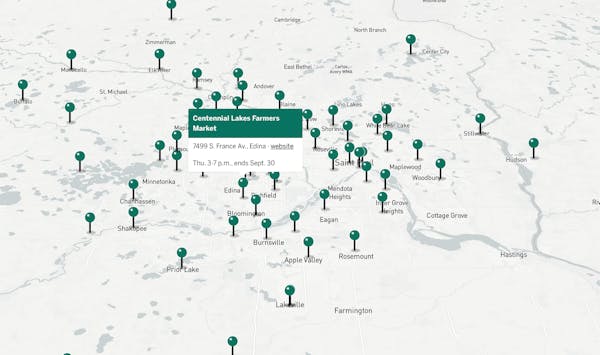Neighborhood farmers markets, with musicians plucking guitars and shoppers casually sniffing homemade soaps, might seem like a low-budget affair.
But low-budget doesn't mean no-budget and many of Minneapolis' most beloved neighborhood farmers markets are at risk of closing down — or already have closed — as financial donations, necessary to keep them running, dwindle.
"We should be done [fundraising] by now. We're not even halfway," said Sarah Knoss, manager of the Northeast Minneapolis Farmers Market, earlier this month.
Usually, by mid-May, the northeast market has raised $25,000. This year, it has yet to tally half that amount.
The jangly blues music, ruddy stalks of rhubarb and stroller-pushing parents disguise the financial strain of the market, which pops up every Saturday morning in the parking lot of Church of St. Boniface near University Avenue NE. and 7th Street.
"When the target is not that high, and we can't even reach that target, it's really alarming," said Julie Wong, a northeast market board member and owner of a salmon jerky business.
Northeast Farmers Market is teetering, but it isn't the only one struggling. There will be fewer markets this year in Minneapolis and surrounding communities. Some, like the Nokomis market, couldn't raise necessary funding to reopen.
Organizers cite myriad causes. The northeast market's 501(c)(4) tax-exempt status doesn't allow donors to write off gifts. And the end of federal stimulus checks has left some small businesses in catch-up mode.
Almost everyone points to the pandemic.
"I think there was a 'man the ramparts' attitude throughout the pandemic that made people say, like, 'Yes, farmers markets are important,'" said Ryan Pesch, a University of Minnesota Extension educator in Otter Tail County. "Now, there's a coming out of the pandemic for everybody. Things are kind of wonky right now."
For some longtime sponsors of the Northeast Farmers Market, the depressed giving has motivated them to increase donations. Stinson Wine, Beer and Spirits is a longtime sponsor that experienced a "different side" of the pandemic than on-premise restaurants, said owner Daniel Mays.
"We were really busy," said Mays. "So we've made it even a bigger point to strengthen our support because we know there are places that couldn't give as much."
But organizers don't expect a single business to make up for the drop-off in support.
Neighborhood Roots is a nonprofit that runs three small farmers markets across Minneapolis. Erin Swenson-Klatt, vice chair of its board, said the organization raised nearly $37,000 in business sponsorships in 2018. Last year, it raised just $6,000.
"Many small businesses were hit really hard by the pandemic and needed to pull back," Swenson-Klatt said.
In the last year, Neighborhood Roots cut staff and closed the Nokomis market, with hopes to re-open it in 2023. Surprisingly, many organizers say, the funding challenge comes on the heels of two banner years for some vendors.
Yuri Jelves and his wife, Ivette, run Atacama Catering at the northeast market, selling spicy empanadas and pastries influenced by the flavors of Chile. During the pandemic, Yuri said, business was "super good."
Many vendors are optimistic, even amid soggy growing conditions.
"We're just starting to grow our plants," said Kristy Yang, who translated in Hmong for her mother, Shelley. At the season's height, their stand will carry a colorful array of beets, carrots, green onions, cilantro, cucumbers and tomatoes from their farm near Rosemount. "Our grandma has been here for 10 years, and she kind of got us into it."
Up the aisle, under a red sign that says "Foley Farms," Tania Kostenko, an immigrant from Ukraine, stood proudly before a row of bundled asparagus.
"It's just the beginning," said Kostenko, naming off the fruits and vegetables she'll soon carry: raspberries, strawberries, blueberries, sweet corn and cantaloupe. "It's going to be like four tables."
Minnesota has seen a boom in farmers selling directly to consumers, now numbered at 3,500 farms, according to the Minnesota Department of Agriculture.
A decade ago at the northeast market shoppers could park in the St. Boniface parking lot. Now, with more than 100 vendors, the event attracts up to 2,000 people to the neighborhood — and cars must be parked on the street.
Buyer behavior has also changed since the earlier phases of the pandemic when shoppers bought their goods and promptly left.
"Now, there's going to be more browsing, hanging out, just kind of being here," said Knoss.
Vendors pay fees for the market's upkeep, for electricity and a storage shed. But there are unseen costs of the market, too, such as paying child care workers and musicians. Renting the church parking lot. Advertising. Knoss's own salary.
On the morning of May 14, the wind broke a tent.
"That tent is $200," said Knoss.
Most market boosters who spoke with the Star Tribune believe the biggest in the city's farmers market scene — like Mill City Farmers Market — will continue to thrive.
But Martha Archer, executive director of Mill City Farmers Market, said the market has seen recent declines in giving from major sponsors.
"We stayed open during the pandemic. So people see money changing hands," Archer said. "There's so much that needs to be funded in this city."
At the northeast market, Tracy Roy and Ifrah Esse sat on a bench eating Indian food near a glass-encased statuette of the Virgin Mary. Roy had a habanera pepper plant in a grocery sack at her feet.
"I've gone to the other farmers markets, like, the big one by the 94 freeway," said Esse. "But I like one that's a little smaller because you get to see everyone and relax a little more."
Organizers believe if more people understood the money required to run neighborhood markets, they might donate.
"Every farmers market right now is in a precarious situation compared to three years ago," said Swenson-Klatt. "Even if you can't see it."
Anoka expands downtown sip-and-stroll 'social district'

